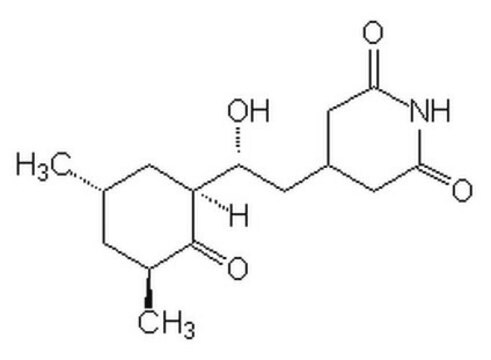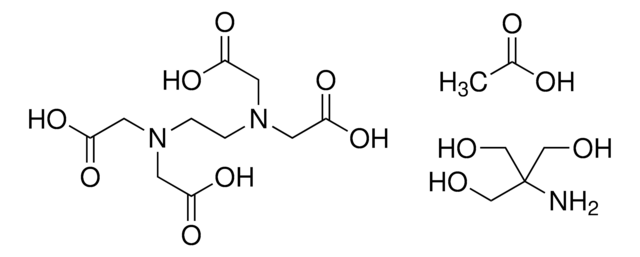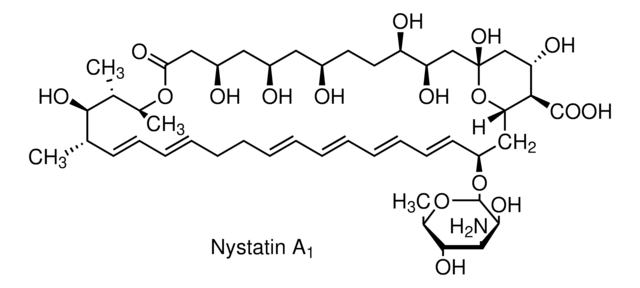Kluczowe dokumenty
46401
Cycloheximide
PESTANAL®, analytical standard
Synonim(y):
3-[2-(3,5-Dimethyl-2-oxocyclohexyl)-2-hydroxyethyl]glutarimide, Actidione, Naramycin A
About This Item
Polecane produkty
klasa czystości
analytical standard
Poziom jakości
opis
mixture of stereo isomers
linia produktu
PESTANAL®
Próba
≥95% (HPLC)
okres trwałości
limited shelf life, expiry date on the label
metody
HPLC: suitable
gas chromatography (GC): suitable
rozpuszczalność
H2O: slightly soluble
spektrum działania antybiotyku
fungi
Zastosowanie
agriculture
cleaning products
cosmetics
environmental
food and beverages
personal care
Format
neat
Tryb działania
protein synthesis | interferes
temp. przechowywania
−20°C
ciąg SMILES
[H][C@]1(C[C@@H](C)C[C@H](C)C1=O)[C@H](O)CC2CC(=O)NC(=O)C2
InChI
1S/C15H23NO4/c1-8-3-9(2)15(20)11(4-8)12(17)5-10-6-13(18)16-14(19)7-10/h8-12,17H,3-7H2,1-2H3,(H,16,18,19)/t8-,9-,11-,12+/m0/s1
Klucz InChI
YPHMISFOHDHNIV-FSZOTQKASA-N
Szukasz podobnych produktów? Odwiedź Przewodnik dotyczący porównywania produktów
Opis ogólny
As per Regulation (EC) No 1107/2009, repealing the directive 91/414, cycloheximide is not approved for use in the European Union (EU).
Zastosowanie
- To evaluate the antifungal efficacy and safety of cycloheximide as a supplement in Optisol-GS
- To study the effect of cycloheximide on leaf-cutting ant workers
- To study the effect of streptomycin, cycloheximide, fungizone, captan, carbofuran, cygon, and pentachloronitrobenzene on soil microorganisms
- To study the fungal control of nitrous oxide production in a semiarid grassland
- To study the activity and degradation of streptomycin and cycloheximide in soil
Działania biochem./fizjol.
Activity Spectrum: Active against yeast and fungi like Candida, Aspergillus, Saccharomyces, Penicillium
Informacje prawne
Hasło ostrzegawcze
Danger
Zwroty wskazujące rodzaj zagrożenia
Zwroty wskazujące środki ostrożności
Klasyfikacja zagrożeń
Acute Tox. 2 Oral - Aquatic Chronic 2 - Muta. 2 - Repr. 1B
Kod klasy składowania
6.1A - Combustible acute toxic Cat. 1 and 2 / very toxic hazardous materials
Klasa zagrożenia wodnego (WGK)
WGK 3
Temperatura zapłonu (°F)
Not applicable
Temperatura zapłonu (°C)
Not applicable
Środki ochrony indywidualnej
Eyeshields, Faceshields, Gloves, type P3 (EN 143) respirator cartridges
Wykazy regulacyjne
Wykazy regulacyjne dotyczą głównie produktów chemicznych. Można w nich podawać ograniczoną liczbę informacji na temat produktów niechemicznych. Brak wpisu oznacza, że żaden ze składników nie znajduje się w wykazie. Użytkownik odpowiada za zagwarantowanie bezpiecznego i zgodnego z prawem stosowania produktu.
EU REACH Annex XVII (Restriction List)
Wybierz jedną z najnowszych wersji:
Masz już ten produkt?
Dokumenty związane z niedawno zakupionymi produktami zostały zamieszczone w Bibliotece dokumentów.
Klienci oglądali również te produkty
Nasz zespół naukowców ma doświadczenie we wszystkich obszarach badań, w tym w naukach przyrodniczych, materiałoznawstwie, syntezie chemicznej, chromatografii, analityce i wielu innych dziedzinach.
Skontaktuj się z zespołem ds. pomocy technicznej













